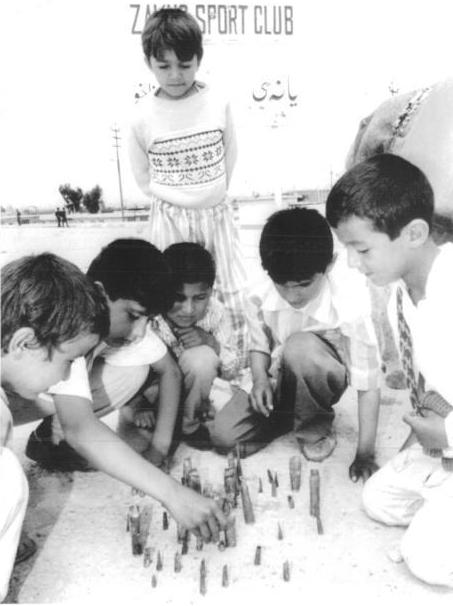
Iraqi Activities

Figure 1.--The Persian Gulf War was conducted (August 1990-February 1991). The actual ground campaign phase lasted only 100 hours. An armistice was signed (February 28, 1991). This was immediately followed a series of popular rebellions in the north (he Kurds) and southern Iraq (the Shi'ia) (March and April 1991). Both were brutally supressed by Sadam's surviving, but still well-armed military. Here Kurdish children play with e military catridges that littered the ground after the fighting. The press caption read, "Iraqi children play games with empty bullet cases of varting size collected in the Zakho vicinity. Many buildings in Zahko, especially military baracks and governmental buildings, have broken windows, are burned, or completely destroyed -- evidence of heavy fighting." The photograph was dated April 25, 1991.
|
|
School and religion seem the most important boyhood activities in Iraq. Oil mony enabled Iraq to begin to build a modern education system, but as with much else, Sadam allowed the country's developing infrastructure to deteriorate as he squandered the country's oil ernings on military equipment and ruionous foreign adventures. Since the Arab conquest (7th century), the country has been largely Muslim with an important Christian minority. Christians since the fall of Sadam have come under increasing pressure from fanatical Muslims. Many have had to flee to other countries for safety. As in most Muslim Middle Eastern countriSport is very important in most modern countries. Sport is becoming more important, but still not a major activity in most modern Arab countrie. Sport is not as important for children as is the case for other areas. This is even true for boys and is basically a minor activity for girls. While sport is just beginning to be established, children have played a variety of games. One sources tells us that 'kids in Iraq play kick the can and soccor in the middle of the street.' By kids here they means boys, but this a modern view. Tin cans were not invented until the early-19th century mand not common until after mid-century. And much later in Iraq. A for soccer, we doubt that many kids (again boys) played soccer until after World War II and the oil boom began. The children must have played a variety of trditional games such as tag, ring games, and board games. We have not yet been able to find details. Girls surely participated in some of these. Of course Iraq despite it historical importance became very poor area after the deline of the Calioagte (9th century AD). As a resilt most childe worked from a very early age and had very little time for play.
HBC

Related Chronolgy Pages in the Boys' Historical Web Site
[The 1880s]
[The 1890s]
[The 1900s]
[The 1910s]
[The 1920s]
[The 1930s]
[The 1940s]
[The 1930s]
[The 1940s]
[The 1950s]
[The 1960s]
[The 1970s]
[The 1980s]
Related Style Pages in the Boys' Historical Web Site
[Long pants suits]
[Knicker suits]
[Short pants suits]
[Socks]
[Eton suits]
[Jacket and trousers]
[Blazer]
[School sandals]
[School smocks]
[Sailor suits]
[Pinafores]
[Long stockings]
Navigate the Boys' Historical Clothing Web Page
[Return to the Main Iraqi history page]
[Return to the Main Iraqi page]
[Introduction]
[Activities]
[Biographies]
[Chronology]
[Clothing styles]
[Countries]
[Bibliographies]
[Contributions]
[FAQs]
[Glossaries]
[Images]
[Links]
[Registration]
[Tools]
[Boys' Clothing Home]
Created: 12:22 AM 4/18/2019
Last updated: 12:22 AM 4/18/2019



